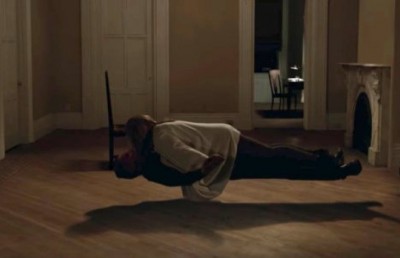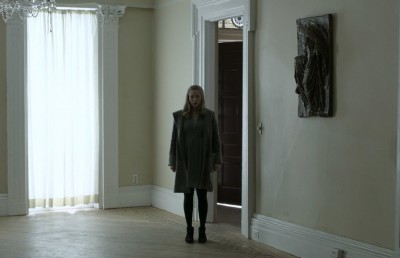FNC 2018 : Pink Screens
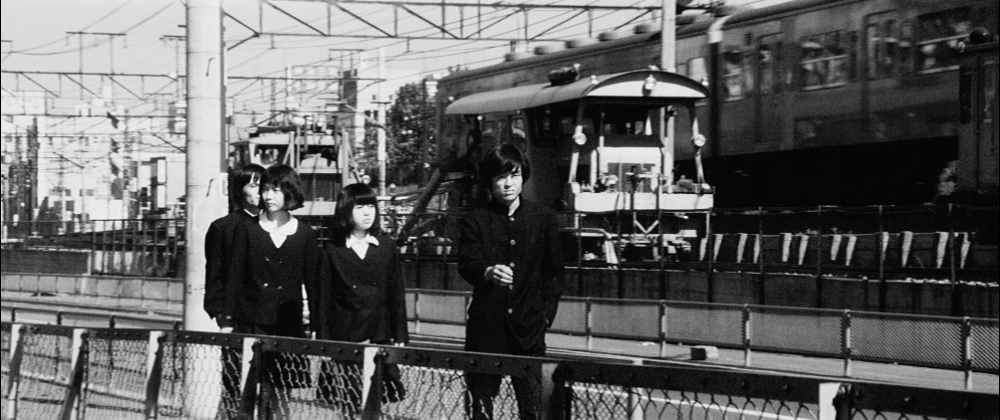
As the leaves are turning red, Montréal screens are turning pink for this year’s Festival du nouveau cinema whose “Temps 0” section proposes a short program of three films from Japan’s storied genre of soft-core pornography, Pink Film, that allows us to sketch out some of the more interesting and experimental contours of this shape-shifting ever surprising genre. I don’t have to point out the importance of settling down with some old-school eroticism once in a while, especially within the hustle and bustle of a film festival where one can quickly become submerged in the barrage of the new and lose sight of oneself amid the myriad options on display. At three films, the selection might appear skint, but the range of approaches to both the idea of genre and the body is doubly impressive for its modest size in line with the low-down origins of the genre and its no-budget ethics.
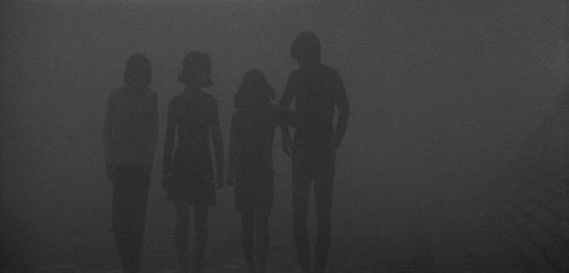
Gushing Prayer
Perhaps now a word as to what exactly Pink Film or Pinku actually is. As mentioned, Pink cinema is a type of erotic cinema endemic to Japan that first saw the light in the early sixties as Japan’s censorship laws loosened and a new generation invaded cinemas both behind the camera and in front of screens. At first an underground affair that attracted both hustlers in it for a quick buck and young radical artists looking for a cheap outlet for political experiments, the genre morphed in the seventies as the studio system scrambled to regain an audience fragmented and lost to television and latched onto Pinku. As the decade progressed, Pink Film actually came to represent the majority of Japanese film production peaking at 70%, once again attracting young filmmakers eager to make movies. The genre ultimately declined in the eighties and nineties with the introduction of hard-core pornography or AV into the market so that now it survives in a few specialty theaters littered across the archipelago and on direct-to-video. What pushes the genre apart from pure pornography, apart from a lack of unsimulated sex, and into the realm of serious critical attention (hence its presence at a prestigious film festival and this article) is the range of visions Pink Film has housed in its 50 plus year history. The genre has produced more than its fair share of boring by-the-number soft-core, but it’s also permitted, given its low-budget, little oversight ethos, a number of artists to get their shot at directing as long as they stuck to a few guidelines (short running time, 4 to 5 sex scenes, etc.). We therefore have an almost infinite number of possibilities as to what the genre could look like. Sci-fi Pinku? Check! Horror Pinku? Check! Musical, parodic, political, romantic Pinku? Check, check and Check!
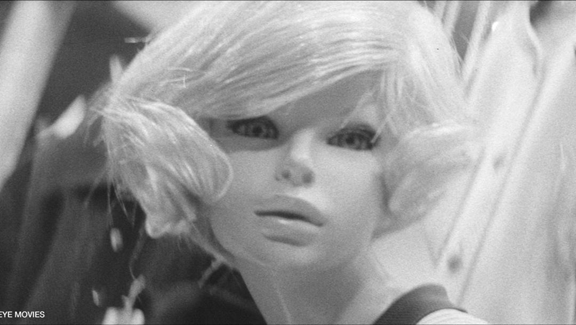
Inflatable Sex Doll of The Wastelands
So let’s start with our first film; 1967’s Inflatable Sex Doll of The Wastelands (it’s a well-know fact that Pink films have the best titles) by Atsushi Yamatoya, frequent screenwriter of Japanese film legend Seijun Suzuki, most famously contributing to the seminal hit-man freak-out Branded to Kill. Inflatable, in some ways, reads like a more risqué take on Suzuki’s wild cinematic jam sessions, playing around with icons of genres, the story and characters morphing on the screen at the director’s whims, conceits of space and time merely suggestions. The film’s story, the hard-boiled tale of a detective hired to investigate the filmed rape and murder of a rich realtor’s girlfriend, is more of an excuse to hang hallucinatory scenes in an ouroboros-like structure exploring everything from the projected masculinity of genre codes, to the violence of filming bodies to the malleability of the cinematic form itself.
The film exudes a strange instability, like the celluloid could break at any moment, the screen falling down to reveal one of the characters pointing a gun directly at the audience, and will surely not be to everyone’s taste, scenes of sexual violence notwithstanding. But for people in search of a subtly smart deconstruction of genre tropes draped in the clothes of a trip-out film with gorgeous high contrast black-and-white images, there are few films outside of the Suzuki canon that can give this film a run for its whacked-out beauty.
Inflatable is also an interesting entry point into a discussion of Pinku since it seems to be using the budding genre to comment on another more established genre, namely the potboilers that Nikkatsu, in particular, was putting out at the time. Yamatoya takes the opportunity of Pink Film, the low-budget, the sex scenes, to investigate, to probe at the veneer of a more respectable genre, questioning its sexual politics, its construction of gender, its use of violence. This toying with cinematic convention, this intertextuality is perfectly in line with the form of the film which uses its frequent breakdown of the relationship between sound and image, its experimental Jazz soundtrack and meta narrative to create a dreamlike world of barren landscapes, empty hangars and smoky jazz bars animated by a playful, questioning logic all its own.
Yamatoya’s relationship to genre can be understood almost musically, codes and conventions offering something like a melodic backbone against which the director bounces and riffs. Sometimes he leans into those notes, often he plays against the expected, deepening the register of a flailing genre. In this labored analogy, Pinku acts as a liberating agent, a meta-genre which allows Yamatoya an aerial view of the potboiler, its demands of sex easily met in its tale of a quest for an illicit stag film by a womanizing private eye. This mixing of genre facilitates a loosening up of genre demands, the move away from the industrial pace of big studio filmmaking towards the more down-low expectations of the underground, making possible a more free-spirited, sometimes parodic, always formally daring relationship to the source text, something which would get Yamatoya’s friend Seijun Suzuki fired from Nikkatsu just a few years later. In that sense, genre or genres take the form of a beloved standard allowing a skilled craftsman the opportunity to surprise us with his virtuoso tricks, and in the process reinvigorate a tired classic. Here the doubling of genres permits a formal and narrative freedom that leads to a potent uncovering and subversion of sexual politics within the detective story that exists not in spite of, but because of this mixing.
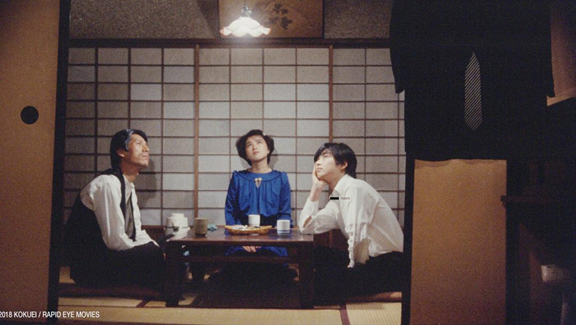
Abnormal Family
A similar intertextuality is to be found in Abnormal Family (1984), the first film from Masayuki Suo, who would go on to a long career making gentle comedies and police procedurals, but perhaps best known for the mega-hit Shall We Dance? (1996). Abnormal Family is one of those films you can pitch in three words and those three words will no doubt put a glimmer in specific cinephiles’ eyes; Ozu Porn Parody. The story of a young housewife whose carousing husband forces her to take refuge in the comforting and understanding arms of her step-father evokes such masterpieces as Late Spring (1949), although its plot hews closer to the Naruse masterwork Sound of the Mountain (1954).
Less a spoof than a loving homage, the satire is largely harmless, pointing out the ineffectualness of the husband figure, the latent incest in Ozu’s familiar scenarios of tight-knit families, the fear and incomprehension of youngsters, although the homosexual angle is left untapped. No, what is of real interest is Suo’s recycling of Ozu’s film style: the pillow shots, the straight angles, the geometric framing, for the purposes of eroticism. Here there is a real commentary, stripping out Ozu’s tender humanism and focusing his gaze on bodies feels more like an act of film criticism than a simple pastiche, forcing the viewer to rethink the late filmmakers work in a more formalist light. From the very first scene, a marital lovemaking session filmed in boxy unmoving frames focusing alternatively on the breasts, hips and faces of the actors, Suo’s studious approach starts paying dividends. The way bodies strain against the edges of the static frames highlights the paradoxical joy of Ozu’s cinema, how this most unrepentant of formalist could also be our most potent humanist.
This, at first glance harmless, bit of pastiche starts revealing more depth in its approach as one starts to think not of the of the surface similarities to the master’s oeuvre but of the continued engagement and rethinking of a specific film style. This style, which the film isolates as a way to view space, to stage the meeting of bodies and to pace out those interactions in measured, soft cadences, can then be repurposed either for gently humanist musings on what it means to be human, or, as is Suo’s wont, for erotic purposes. The sex scenes are therefore where Suo can most deviate from Ozu’s thematic concerns and in the same movement engage most clearly with his formal approach. Like Ozu, Suo breaks up bodies, focusing frontally or laterally on the most expressive details of the human anatomy, for Ozu the face and torso or the seated silhouette, for his student, the various erogenous zones. Suo’s approach is more outwardly radical as he will sometimes break up bodies along geometric lines (a sex scene taking place in the marital bedroom against Japanese paper sliding doors acting almost like a quadrille is particularly clever in its mathematical beauty), with the liberty of sex offering more varied ways to contort and stretch out. But like in Ozu, who would often leave ample space for the floor and the ceiling in his frames, flattening them out like a traditional painting, bodies occupy a flat space almost as if they are part of the décor, another plastic point of reference within the frame. This recentering of a specific filmic style, in that sense, both allows for a new vision of bodies within the Pink genre, as well as a renewed engagement with the great master’s works. Like all the best pieces of criticism it creates as much as it elucidates.
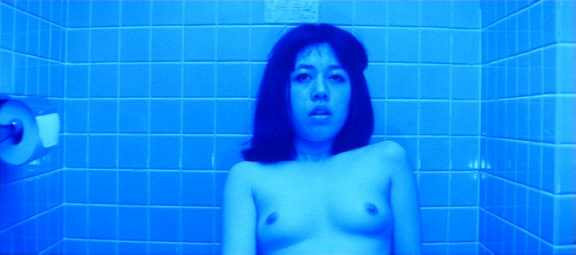
Which brings us to the last film of the retrospective and also my last of the festival, and no doubt the most radical piece of art on offer: Masao Adachi’s Gushing Prayer (1971). Adachi, known as the partner in crime and screenwriter to Pinku icon Koji Wakamatsu and member of the PLO in Lebanon, is a fascinating director in his own right pushing the radical leftist rhetoric farther than his compatriot ever could have imagined and building sex films around radical political discourse. Gushing Prayer, is less a story than a series of debates centering around uncertain figures, a 15-year old prostitute, a male friend, a lecherous teacher. Here the genre becomes pure rhetoric, a space to hash out arguments of the day around sex and society, populated by sketches of characters spouting off Marxist and Maoist slogans. The film is the one most at risk of alienating viewers (something it no doubt wishes to accomplish), there is nothing remotely sexy about it, it treats the idea of a plot like a cancer patient, and good luck trying to make sense of its debates if you don’t have at least passing knowledge of the political situation of Japan in the late sixties.
But what fascinates about the film beyond its uncompromising spirit and gorgeous saturated black and white cinematography is the way it treats genre as a series of codes and discourses which can be used, reshaped to form a coherent political discourse, in this case around the disenfranchisement of Japanese youth and their uneasy relationship to sex. In that sense, Adachi hews closer to art cinema, the experiments of Oshima, Yoshida or even Akio Jissoji’s Buddhist films in trying to bend the language of cinema in the direction of theory. Adachi is not trying to entertain, but to use every tool of cinema —the cinematography, montage, actors— and orient them towards a particular leftist and feminist discourse around female sexual liberation and all the social forces that hinder and help it.
To this end, Adachi purifies the image, akin to the protagonist, a 15-year old prostitute in a quest to “beat” sex itself, pushing the contrast of his black-and-white images, sometimes punctuated by colour and tinted images, and setting his story in barren landscapes and antiseptic white rooms. The effect, like his rhetoric inflected dialogue, is sometimes similar to reading a political pamphlet, sparse and to the point, utilising narrative and metaphor in the service of a greater political point. Sex, the raison d’être of the Pink Film, is also similarly put to use, emptied out of its erotic charge by Adachi’s cold, analytical camera, it becomes another point of analysis, a further method of questioning the image and potentials of sex in a capitalist society. Adachi is interested in codes, in social contracts, in all the state apparatus that invisibly bind and cajole us everyday into a state of subservience, and genre itself a set of codes more or less spoken aloud, offers him the perfect terrain to question and reconsider the large questions of our time.
Here, genre becomes an analytical tool, a set of demands and conventions that can be questioned, subverted and linked to larger political questions. Sex, like any other demands of cinema, be it the need of narrative, of editing, of character, is reconsidered in light of Adachi’s radical politics and criticized, refashioned, rethought. Conventional narrative is replaced by a series of encounters that lead to discussions around the topics of sex, violence, society, education, youth, often broken up by violent sex scenes and moments of contemplation that harken back to Adachi’s landscape theory (as evidenced in his film A.K.A. Serial Killer). Characters appear more like sketches, mouthpieces to espouse theory than fully-fledged human beings. This all seems deliberate, a way to distance ourselves from the bourgeois illusions of cinema and force us to reconsider the relationships of power that undergird things as fundamental as sex and being. In that sense, Adachi finds a potent metaphor in Pink Film itself, occupying a strange grey-zone between exploitation and counter-culture, between sexual liberation and the commodification of sex, between free bodies and subservient ones. Pink Film demands sexual liberation, to see what had been hidden for so long in Japanese cinema, but it also commodifies, regulates this liberation, demanding a certain number of sex scenes per films, hiding genital parts, faking “real” sex. Adachi had found a way to produce his radical film work within this frame work, which as we’ve mentioned was rapidly changing with the coming of the major studios, but Gushing Prayer presents something of an impasse, an irresoluble contradiction within his own practice. It represents his most sustained engagement with the question of sex, a topic that always undergirded (perhaps by necessity) his work in the Pink genre.
What’s interesting is, as opposed to other political filmmakers of the time who believed to have found a way for a new political cinema to express the contradictions of society (think of Godard’s Maoist films), Adachi’s attempt results in apparent failure. The main characters last words as she flushes her unborn child down the toilet is “I couldn’t beat sex”. Right after, a text reading: “Do not conduct an autopsy. Nobody will ever understand the inner me”, flashes on the screen. Not long after, Adachi would leave Japan to join the Japanese Red Army in Lebanon and fight alongside the Palestinian revolution.
Those three films, whilst seeming dramatically opposed on the surface, each offer a personal vision of genre and its possibilities. We have the genre as jazz riff, as critical essay and as analytical tool. No doubt some will prefer one approach above the others, but what those films and this program offers is a space that forces us to rethink genre as more than simply an industrial practice or a type of audience engagement, but as a fully-fledged intellectual discourse in its own right, a way to think cinema, its history, and its relationship to the world. Genre is a canvas, some will draw within the lines, others will set them on fire whilst shouting Marxist slogans.


